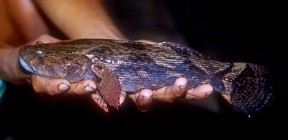Oxyeleotris marmorata
Marbled Goby
Classification
Eleotridae
Distribution
Thailand, Cambodia, Laos, Vietnam, Indonesia, Malaysia, Phillipines, Brunei Darussalam.
Habitat
Occurs in various biotopes, including rivers, ponds, swamps and flooded forests. It generally prefers areas of little or no water movement. Mainly found in freshwater but is also found in brackish environments.
Maximum Standard Length
26″ (65cm), usually smaller in aquaria.
Aquarium SizeTop ↑
A sedentary species, so a tank measuring 60″ x 24″ x 24″ (150cm X 60cm X 60cm) – 565 litres ought to be enough for all but the very largest specimens. Young fish can obviously be grown on in smaller tanks.
Maintenance
The fish like to dig, and sometimes partially bury themselves, so a soft substrate of sand, several inches in depth is recommended. Provide hiding places using large chunks of bogwood, lengths of plastic piping, or clay flowerpots. Dim lighting is also preferable, as this is essentially a nocturnal species.
Water Conditions
Temperature: 72-82°F (22-28°C)
pH: 6.5-7.5
Hardness: 10-15°H
Diet
Although strictly carnivorous in nature, many captive specimens can be trained to take dried pellets. It should definitely be offered a meat-based diet, however. Young fish will accept bloodworm, small earthworms etc., while larger fish will take whole prawns, large earthworms, lancefish and other similar foods. Take care not to overfeed as these fish are very greedy indeed.
Behaviour and CompatibilityTop ↑
Territorial with its own kind and will consume any fish it can fit in its capacious mouth. It is therefore best kept alone, although we have seen large specimens coexisting with other similarly-sized fish that inhabitb other parts of the aquarium, such as arowana. Obviously, a very large tank would be required if this is to be attempted.
Sexual Dimorphism
Male fish have a longer anal fin and more extended second dorsal fin. Apparently the genital papilla is also more pointed in the male than in the female.
Reproduction
Not thought to have been bred in captivity. Any attempt would surely prove problematic, due to the adult size of the fish and their territorial, predatory nature.
NotesTop ↑
One of the largest goby species in the world, O. marmoratus is unsuitable for the vast majority of aquaria, but is an interesting oddball for the true enthusiast with the facilities to house it properly. It is a nocturnal ambush predator and generally remains motionless during daylight hours unless striking at food. It is a popular food fish in some of its native countries, where it is known as soon hock.



